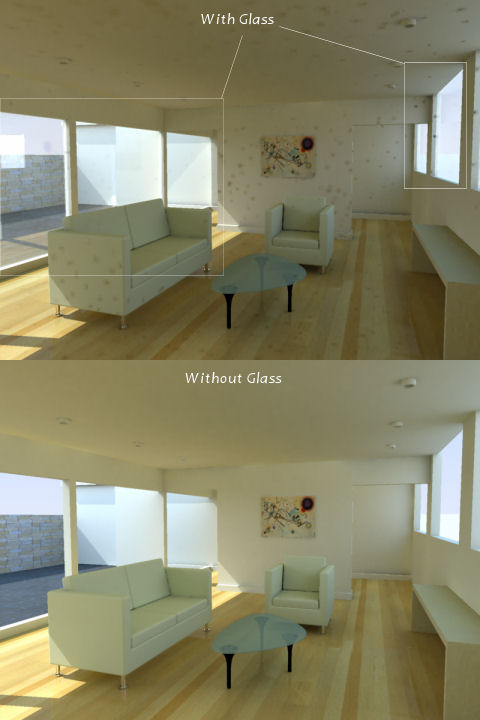Renderosity Forums / Carrara
Welcome to the Carrara Forum
Forum Coordinators: Kalypso
Carrara F.A.Q (Last Updated: 2025 Feb 12 7:20 pm)
Visit the Carrara Gallery here.
Subject: Glass shader causes blotches in GI Render - anyone know why?
Hi Richard, Try enabling "Improved Edges" in the GI renderer and also enable "Full Raytracing" at the top of the regular render settings. Interpolation let's Carrara 'guess' where the photons go instead of actually figuring it out. So, interpolation is giving Carrara permission to make mistakes for the sake of improved render times. Full Raytracing will extend the render times but yields better results because it forces Carrara to do complete calculations. You can also try Interpolation in the 80-100 percent range. That will work somtimes but it depends on the scene. Mark

The thing I notice (which might be fixed by removing interpolation and selecting Full Raytracing) is the errors in ambient occlusion between the back and side walls and the ceiling.
Any thoughts about errors in ambient occlusion?
Thanks
Richard
These are things I learned about Carrara Pro 5.1 through trial and error:
GLOBAL ILLUMINATION
Avoid using Improved Edges.
Use Full Raytracing only if blackness appears in scenes (missing polygons).
Always turn off Interpolation for final renders (a huge render hit will be
taken, though).
Turning on Caustics will allow more Indirect Lighting to work through glass.
But the render takes an extreme hit and the resulting caustics might look
over-kill for a scene.
Turn up a scene's ambient lighting to around 40% before using Ambient Occlusion.
Otherwise, everything will be dark.
www.youtube.com/user/ShawnDriscollCG
Through experimentation, I've discovered some ways to reduce (though not completely remove yet) the ambient occlusion blotches
- Reduce overall light level
- Darken textures a little, and undersaturate colours a little
- Bang all settings as high as your patience and CPU will allow!
- No Interpolation, Full Raytracing
(Am not sure which of these changes has the most effect though)
Overall render will come out darker than desired, ubt this can be reversed by loading into Photoshop (or equivalent), duplicating the image onto a second layer which is given a "Screen" blend mode, and this restores the lightness, but a little detail might be lost.
Quote - These are the render settings. Does anybody have an idea what specific factors could be causing it? It always takes so long to render with this hair, I'd rather not have to do very many test.
Increase ray depth to 8 minimum, and rduce filter sharpness to 65=70%. This gives the room a slightly warmer more realsitic look. Also make sure you dont have something in your scene settings as a background. An image map in there or some kind of procedural could cause problems like those spots.
If you are using realistic sky or sky, just turn it off since it will not really show in the render with the camera angle you are using.
After exhausting all the possibilities I can think of, and rendering at the highest quality available, and after taking note of some hints from 3D professionals (out of Jeremy Birn's "Digital Lighting and Rendering", I've discovered another more lateral approach ...
Export the Carrara scene to a 3DS file, and import into Vue 6 Infinite to take advantage of the higher quality GI and radiosity lighting there!
That's given me some ideas about how I might improve the Carrara renders.
I have removed ashes in the past from similar scenes by not including the Skylight in my GI renders. I instead placed colored distant lights in areas to simulate the skylight. You can probably leave Interpolation on at 20% so the render will finish quickly.
www.youtube.com/user/ShawnDriscollCG
I don' t know if this is the case with Carrara but in another 3D program I have (Shade) if two objects are overlaping it causes rendering errors when using global illumination. I noticed that the walls and ceiling in this Carrara file are overlaping separate peices. Maybe if you used boolean operations to weld them all together it would take away the blotches.
Privacy Notice
This site uses cookies to deliver the best experience. Our own cookies make user accounts and other features possible. Third-party cookies are used to display relevant ads and to analyze how Renderosity is used. By using our site, you acknowledge that you have read and understood our Terms of Service, including our Cookie Policy and our Privacy Policy.















Am experimenting with some renders based on some of the "Indoor" Carrara 5.1 presets.However, when I put glass in the two windows on the left and right of the scene, I get mysterious blotches appearing. Anyone know why?
Render uses Sky dome, and a distant light, with Indirect Light, "Excellent" light quality, 100K photons, 35% photon map accuracy.
I am using the standard "Clear" glass shader with no bump map. Images below are "with" and "without" glass.
Any ideas how to fix this? I have already banged up the quality settings quite a lot but can't get rid of blotches.
Thanks
Richard